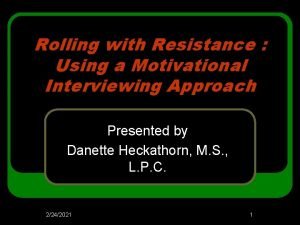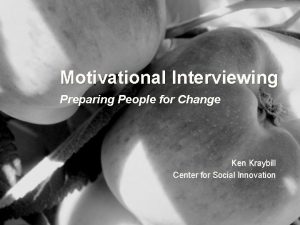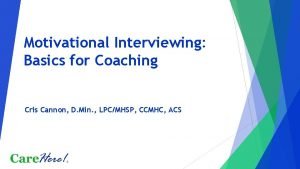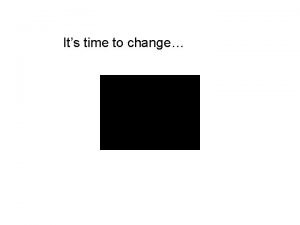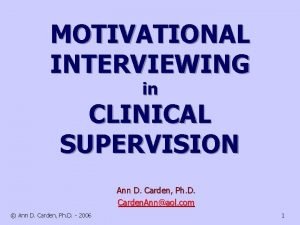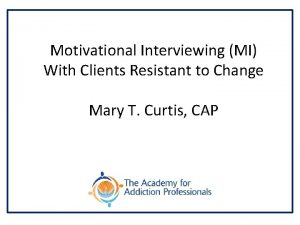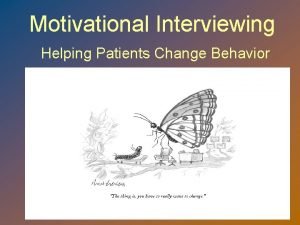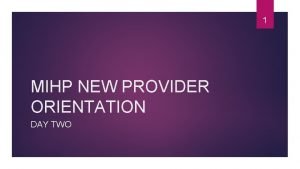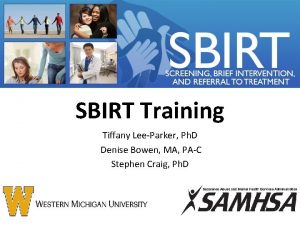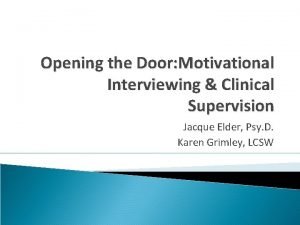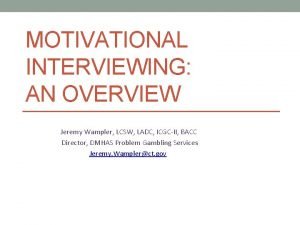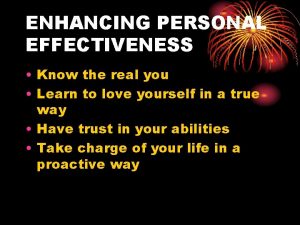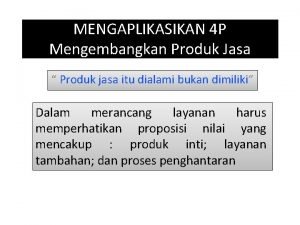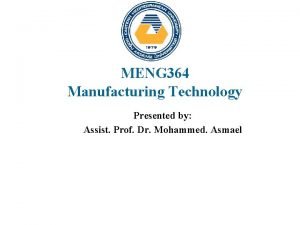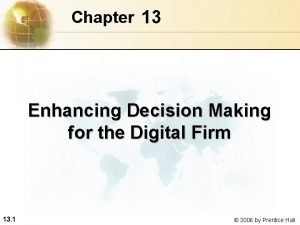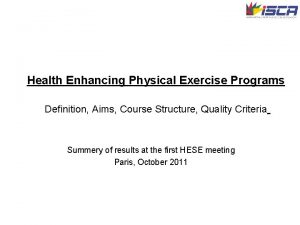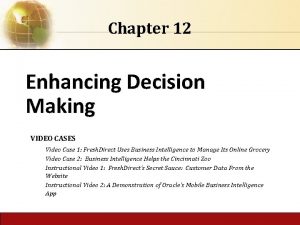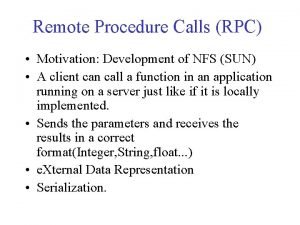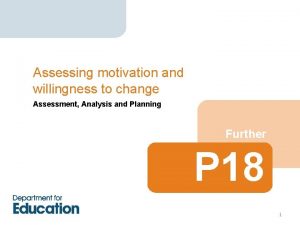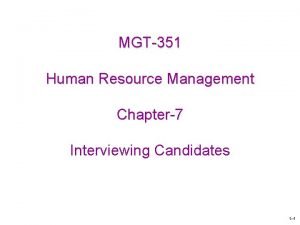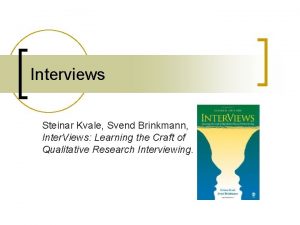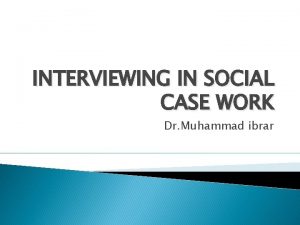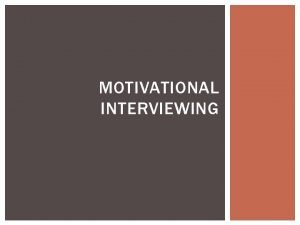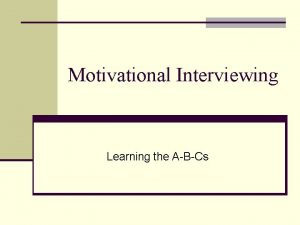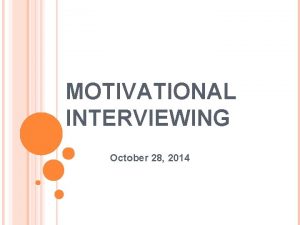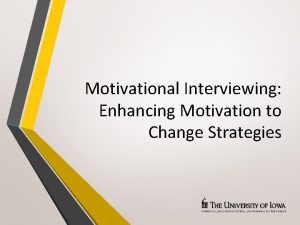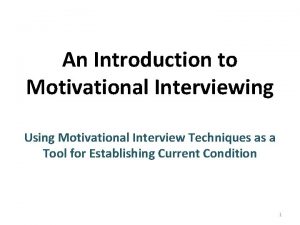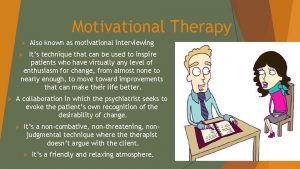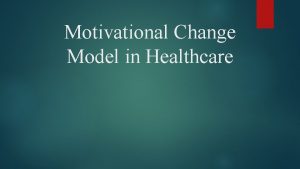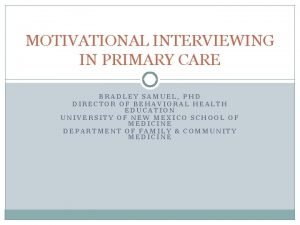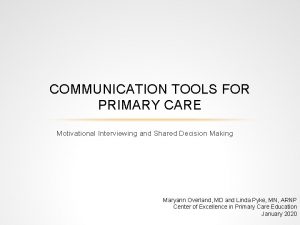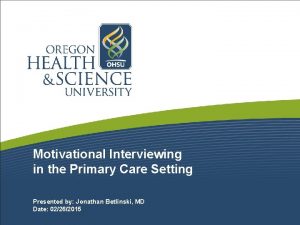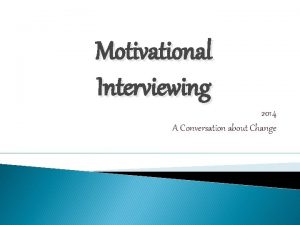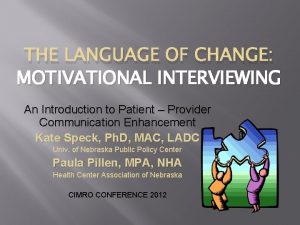Enhancing Motivation to Change Motivational Interviewing in Primary














































- Slides: 46

Enhancing Motivation to Change: Motivational Interviewing in Primary Care April 28, 2017

Agenda Opening Remarks Housekeeping Presentations Q&A Closing Remarks 2

Introduction to the atom Alliance Multi-state alliance for powerful change composed of three nonprofit, healthcare QI consulting companies. 3

Objectives During this Webinar you will learn: • How to describe motivational interviewing as a conceptual model for enhancing patient motivation. • How to identify why the use of highly confrontational interventions are less likely to evoke behavior change. • Discover a list of basic concepts and techniques of motivational interviewing. 4

Housekeeping Items: Chat To ensure maximum sound quality, participant lines have been muted; however we welcome ALL questions and comments via the chat board on the right hand side of your screen To submit questions or comments: • Use Web. Ex chat – send messages to the panelists or all participants using the chat feature drop down menu 5

Housekeeping Items: Q & A To ask panelists questions directly, and privately • The panelist can then decide to answer the question privately (only the person that asked the question will see the response), or the panelist can answer publicly, and all participants will see the question and the answer. 6

Housekeeping Items: Polling During today’s presentations you may be asked to participate in some polling questions. These questions will come up on the right side of your screen. When you do answer a polling question, be sure to hit the submit button so we can capture your answer. 7

Polling Question 1 Which screening tools are you currently using to assess Behavioral Health and/or Substance Abuse? Check all that apply: AUDIT/AUDIT-C NIDAMED CAGE AID DAST-10 PHQ-9 Depression Tool Kit (Mac. Arthur) We are currently not screening for depression We are currently not screening for substance misuse Other _______________ 8

9

Polling Question 2 How comfortable are you with using Motivational Interviewing to address a positive screen with a patient? Uncomfortable Somewhat uncomfortable Neutral Somewhat Comfortable 10

Polling Question 3 Are you familiar with referral resources for Behavioral Health and/or Substance Abuse that are available in your area? Yes No 11

Enhancing Motivation to Change: Motivational Interviewing in Primary Care Suzanne Bailey, Psy. D. Rachel Hovis, M. D. Director of Integrative Services Internal Medicine Physician Cherokee Health Systems Knoxville, TN Cherokee Health Systems Together…Enhancing Life © 2010 Cherokee Health Systems

Our Mission… To improve the quality of life for our patients through the blending of primary care and behavioral health. Together…Enhancing Life Cherokee Health Systems Together…Enhancing Life © 2010 Cherokee Health Systems

Cherokee Health Systems: Merging the Missions of CMHCs and FQHCs Cherokee Health Systems Together…Enhancing Life © 2010 Cherokee Health Systems

Primary Service Area Kentucky Missouri CAMPBELL CLAIBORNE UNION ANDERSON KNOX GRAINGER HAMBLEN JEFFERSON COCKE Tennessee Arkansas LOUDON MCMINN MONROE SEVIER ark al P tion Na n i a unt Mo oky Sm BLOUNT HAMILTON Mississippi Alabama Cherokee Health Systems Together…Enhancing Life Virginia ap d G lan k ber l Par Cum ationa N Georgia © 2010 Cherokee Health Systems North Carolina

Cherokee Health Systems’ Corporate Profile Last Year: 73, 953 patients 353, 552 Services 23, 720 New Patients Number of Employees: 758 Provider Staff: Psychologists - 50 Cardiologist - 1 Psychiatrists - 7 Primary Care Physicians - 37 Nephrologist - 1 NP (Psych) - 10 NP/PA (Primary Care) - 50 LCSWs - 62 Community Workers - 41 Cherokee Health Systems Together…Enhancing Life Pharmacists - 12 Dentist - 2 © 2010 Cherokee Health Systems

Strategic Emphases • Blended behavioral and primary care • Go where the grass is brownest • Outreach and care coordination • Telehealth • Training healthcare providers • Value-based contracting • Healthcare analytics Cherokee Health Systems Together…Enhancing Life © 2010 Cherokee Health Systems

Motivational Interviewing Cherokee Health Systems Together…Enhancing Life © 2010 Cherokee Health Systems

Poor Treatment Engagement & Motivation to Change • • • A systemic problem Directly impacts treatment efficacy Frustrates providers – “I’ve told him a thousand times. He just doesn’t care. ” Cherokee Health Systems Together…Enhancing Life © 2010 Cherokee Health Systems

Why don’t patients change? • Ambivalence – “I don’t want to change, I just want to feel better. ” • Decisional Balance- Costs vs. Benefits • Plan Inconsistent with Values • Stage of Change Cherokee Health Systems Together…Enhancing Life © 2010 Cherokee Health Systems

Stages of Change • Precontemplation- “I don’t have a problem. ” • Contemplation- “I have a problem, but I’m not sure I’ll change. ” • Preparation- “I think I will change soon. ” • Action- “I’m taking action to change. ” • Maintenance- “I’m working to maintain the changes I’ve made. ” Prochaska and Di. Clemente (1983) Cherokee Health Systems Together…Enhancing Life © 2010 Cherokee Health Systems

Ready for Action? • Providers are in the action stage. • Are patients? Cherokee Health Systems Together…Enhancing Life © 2010 Cherokee Health Systems

Common Pitfalls • • Give a lecture Give them a hard time Give them a referral Give up Cherokee Health Systems Together…Enhancing Life © 2010 Cherokee Health Systems

It doesn’t work… • Creates resistance • Causes patients to become defensive – “Yes, but…” • Makes the patient less likely to engage in the desired behavior Cherokee Health Systems Together…Enhancing Life © 2010 Cherokee Health Systems

Changing our thinking about changing our patients • “Motivation to change is elicited from the client, and not imposed from without. ” www. motivationalinterview. org • Accept that patients may leave our office and behave exactly as they did before they arrived. • View ambivalence as part of the disease process. – Not a flaw within the patient Cherokee Health Systems Together…Enhancing Life © 2010 Cherokee Health Systems

What is Motivational Interviewing (MI) • Style of Interacting • A collaborative conversation about change that elicits motivation and commitment from the patient. (Miller & Rollnick, 2010) Cherokee Health Systems Together…Enhancing Life © 2010 Cherokee Health Systems

Motivational Interviewing Efficacy Meta-Analysis of 119 Studies • Results – MI “Works” and has small but significant effect sizes (. 23) collapsed across weak and strong comparison groups. – MI is significantly better than no treatment – MI significantly increased engagement in treatment and intention to change – Compared with 12 -step and CBT: MI took over 100 FEWER minutes of treatment on average yet produced equal effects (alcohol, marijuana, tobacco) Lundahl, B. W. , Kunz, C. , Brownell, C. , Tollefson, D. , & Burke, B. L. (2010). A meta-analysis of motivational interviewing: Twenty-five years of empirical studies. Research on Social Work Practice. 20(2) 137 -160. Cherokee Health Systems Together…Enhancing Life © 2010 Cherokee Health Systems

Motivational Interviewing in a Nutshell • Goal is to avoid creating resistance – no arguments, shaming, persuasion, warnings, or unsolicited advice giving • It is important to get the patient to elicit their own self-motivating statements as to why this change is important to them (“I don’t feel as well as I used to since I gained weight. ”) Cherokee Health Systems Together…Enhancing Life © 2010 Cherokee Health Systems

Motivational Interviewing in a Nutshell • Create a discrepancy between current behavior and patient’s goals/values. (“Smoking keeps me from being as involved with my grandkids as I would like. ”) • Elicit change talk. “Tell me what you know about ____. ” “What concerns do you have about your ____. ” “What would be the best thing that could happen if you changed ____. ” • Listen and Reflect. Restate the patient’s change talk from above, helping them feel understood/heard. Cherokee Health Systems Together…Enhancing Life © 2010 Cherokee Health Systems

Do’s & Don’ts of Motivational Interviewing What to do: • Express empathy – listen, reflect back what the patient has said • Develop discrepancies – “On the one hand, you have trouble breathing when you smoke. On the other hand, you want to go to the park with your kids. ” • Avoid argumentation – you never want to be arguing for change while the patient is arguing against change • Roll with patient’s resistance to plan of care, treatment, or behavior changes • Support patient’s self-efficacy to change Cherokee Health Systems Together…Enhancing Life © 2010 Cherokee Health Systems

Do’s & Don’ts of Motivational Interviewing What to avoid: • The patient OUGHT to change • The patient WANTS to change • The patient’s health is the primary motivating factor for him/her • If patient does not decide to change, the provider has failed • A “tough love” approach is always best • I’m the expert—the patient MUST follow my advice • Negotiation is always the best Cherokee Health Systems Together…Enhancing Life © 2010 Cherokee Health Systems

Specific MI Tools • List of pros/cons for and against behavior change • Assess how important change is to patient and how confident they are they can succeed • Looking back – what has worked in the past? • Looking forward – what would you hope would happen in the future if you made this change? What could you do now? What are the best results you could imagine if you made this change? • Exploring goals – assess match between patient’s current behavior and future goals; explore how realistic goals are; look for discrepancies between current behavior and future goals Cherokee Health Systems Together…Enhancing Life © 2010 Cherokee Health Systems

Make a Plan • Consider options – present different options, try to match patient with best option for their case, but recognize that person may not choose the “right” strategy, and prepare patient for this possibility • Establish a goal – summarize the plan with the patient; assess their readiness to commit to the plan Cherokee Health Systems Together…Enhancing Life © 2010 Cherokee Health Systems

Cherokee Health Systems Together…Enhancing Life © 2010 Cherokee Health Systems

Motivation and Confidence Rulers • On a scale of 1 -10 how important is it for you to make the change? • On a scale of 1 -10 how confident are you in your ability to make the change? Cherokee Health Systems Together…Enhancing Life © 2010 Cherokee Health Systems

Change Talk • • • Guide the conversation Stop and listen Strengthens commitment to change “If, hypothetically, you decided you wanted to cut back on your drinking what could be the potential benefits? ” Cherokee Health Systems Together…Enhancing Life © 2010 Cherokee Health Systems

Stage Matched Interventions Readiness to Change Stages Anticontemplation “I resent your assertion that I have a problem. ” Precontemplation “I don’t have a problem. ” Cherokee Health Systems Together…Enhancing Life Brief Interventions Stop, don’t push. Convey readiness to help in the future. “I respect that you don’t want to talk about __ today. I’d like to partner with you to improve all aspects of your health. Maybe we could talk about __ at another time. ” Don’t push. Ask permission and build awareness by providing personalized information. “Would it be okay if I told you why I am concerned about your __? ” “I worry that your ___ is…” © 2010 Cherokee Health Systems

Stage Matched Interventions Readiness to Change Stages Contemplation “I know I have a problem, but I have no interest in changing at this time. ” Preparation “I’d like to change soon, but need some help determining how to begin. ” Cherokee Health Systems Together…Enhancing Life Brief Interventions Don’t push too hard. Encourage the patient to talk about his/her perception of the problem and discuss the potential benefits of changing. “Would you tell me why you think your __ is a problem? ” “If you decided you wanted to, can you think of potential benefits of changing? ” Reinforce desire to change. “Excellent, we’d like to partner with you to make changes in your __. ” Problem-solve barriers and identify small action steps. “Are there things that are getting in the way of you starting to make changes? ” “Patients often find that __, or __ are helpful first steps. Would you like to try one of these options? ” © 2010 Cherokee Health Systems

Stage Matched Interventions Readiness to Change Stages Action “I’m starting to make changes, but need help to continue to make progress. ” Maintenance “I’ve made changes and am stable, but need help to stay that way. ” Cherokee Health Systems Together…Enhancing Life Brief Interventions Reinforce any progress thus far. Problem-solve barriers and refine action plan. “Are there things that are getting in the way of you making more progress? ” “What have you already tried (or considered trying)? ” “What has been most helpful so far? ” Reinforce maintenance of progress. Identify successful strategies and problem-solve ways to continue to employ these. “Can you identify strategies that have helped you manage your __ successfully? ” “Can you identify any barriers to continuing these strategies to manage your __? ” © 2010 Cherokee Health Systems

Cherokee Health Systems Together…Enhancing Life © 2010 Cherokee Health Systems

Cherokee Health Systems Together…Enhancing Life © 2010 Cherokee Health Systems

Cherokee Health Systems Together…Enhancing Life © 2010 Cherokee Health Systems

Change is a process, not an event. Cherokee Health Systems Together…Enhancing Life © 2010 Cherokee Health Systems

Thank you for joining us! Please complete the survey that will come up as you exit the webinar – we value your feedback in developing future events! Please visit us at www. atom. Alliance. org 44 This material was prepared by atom Alliance, the Quality Innovation Network-Quality Improvement Organization (QIN-QIO), coordinated by Qsource for Tennessee, Kentucky, Indiana, Mississippi and Alabama under a contract with the CENTERS FOR MEDICARE & MEDICAID SERVICES (CMS), a federal agency of the U. S. Department of Health and Human Services. Content does not necessarily reflect CMS policy. 16. ASD 1. 05. 014

On-Demand Learning (ODL) Our On-Demand Learning (ODL) area on www. atom. Alliance. org allows you to participate in archived events when it is most convenient. Live events are usually posted as an ODL opportunity 10 days after the live session. Requirements to participate? Review the list of ODL opportunities Click “Go” Submit your name and other information for documentation Click “Submit” and you’ll have access to the ODL of your choice. Share the opportunity with your peers! 45

Connect with Us Reminders 46 Facebook Twitter Linked. In Pinterest www. facebook. com/at omalliance www. twitter. com/atom _alliance www. linkedin. com/com pany/atom-alliance www. pinterest. com/ato malliance/ This material was prepared by atom Alliance, the Quality Innovation Network-Quality Improvement Organization (QIN-QIO), coordinated by Qsource for Tennessee, Kentucky, Indiana, Mississippi and Alabama under a contract with the CENTERS for MEDICARE & MEDICAID SERVICES (CMS), a federal agency of the U. S. Department of Health and Human Services. Content does not necessarily reflect CMS policy. 17. ASG 1. 02. 007
 What is rolling with resistance
What is rolling with resistance Nimi singh
Nimi singh Ken kraybill
Ken kraybill Motivational interviewing
Motivational interviewing Dears motivational interviewing
Dears motivational interviewing Motivational interviewing schizophrenia
Motivational interviewing schizophrenia Motivational interviewing basics
Motivational interviewing basics Dears motivational interviewing
Dears motivational interviewing Ears in motivational interviewing
Ears in motivational interviewing Motivational interviewing case management
Motivational interviewing case management Motivational interviewing
Motivational interviewing Example of double sided reflection
Example of double sided reflection Mi readiness ruler
Mi readiness ruler Motivational interviewing
Motivational interviewing Change talk worksheet
Change talk worksheet Dares motivational interviewing
Dares motivational interviewing Stages of change social work
Stages of change social work Darn cat motivational interviewing
Darn cat motivational interviewing Motivational interviewing
Motivational interviewing Agreement with a twist motivational interviewing
Agreement with a twist motivational interviewing Reds motivational interviewing
Reds motivational interviewing Darn cat motivational interviewing
Darn cat motivational interviewing Motivational interviewing
Motivational interviewing Darn cat motivational interviewing
Darn cat motivational interviewing Darn cat motivational interviewing
Darn cat motivational interviewing Jeremy wampler
Jeremy wampler Motivational interviewing wiki
Motivational interviewing wiki Four enhancing qualitative characteristics
Four enhancing qualitative characteristics Enhancing professional practice
Enhancing professional practice Enhancing professional practice
Enhancing professional practice Enhancing personal effectiveness
Enhancing personal effectiveness Enhancing supplementary services
Enhancing supplementary services Enhancing thermal conductivity of fluids with nanoparticles
Enhancing thermal conductivity of fluids with nanoparticles Enhancing the performance of grade vi-c
Enhancing the performance of grade vi-c Privacy-enhancing computation
Privacy-enhancing computation Explain property enhancing operations
Explain property enhancing operations Enhancing a presentation with multimedia
Enhancing a presentation with multimedia Enhancing professional practice a framework for teaching
Enhancing professional practice a framework for teaching Enhancing decision making
Enhancing decision making History of performance enhancing drugs
History of performance enhancing drugs Health enhancing physical activity definition
Health enhancing physical activity definition Enhancing decision making
Enhancing decision making What is the primary motivation for development of rpc
What is the primary motivation for development of rpc Assessing motivation to change
Assessing motivation to change Chapter 7 interviewing candidates
Chapter 7 interviewing candidates Kvale seven stages of interviewing
Kvale seven stages of interviewing Interviewing in social case work
Interviewing in social case work
